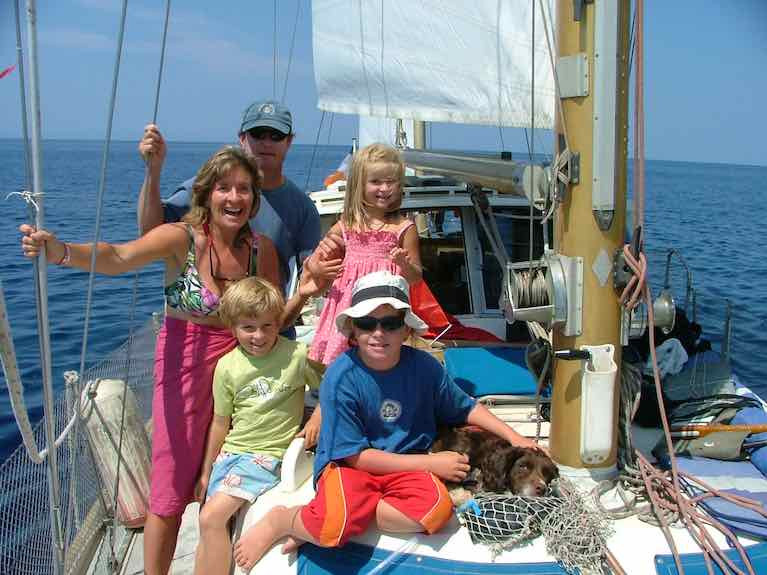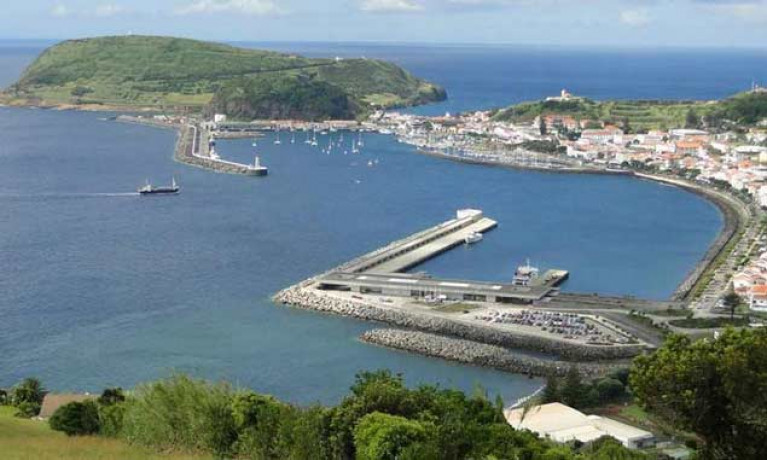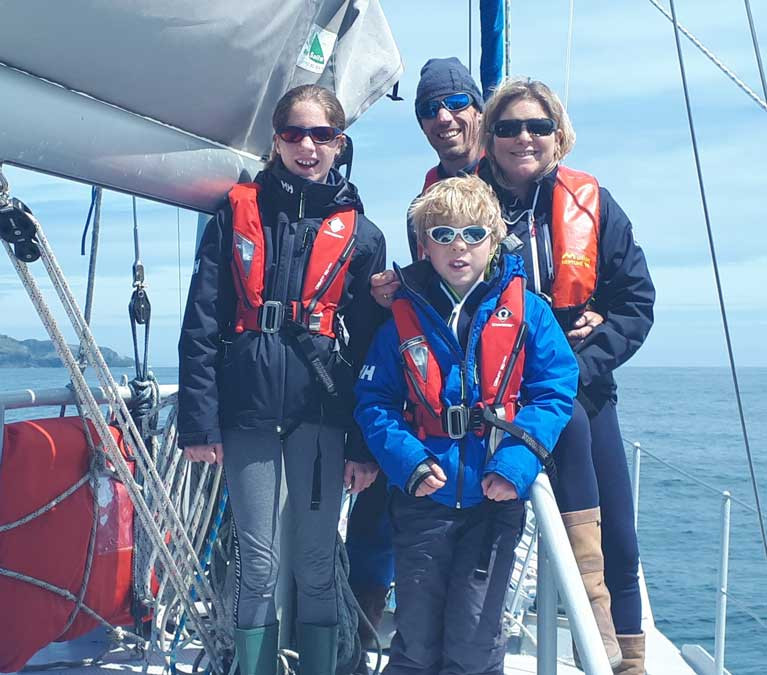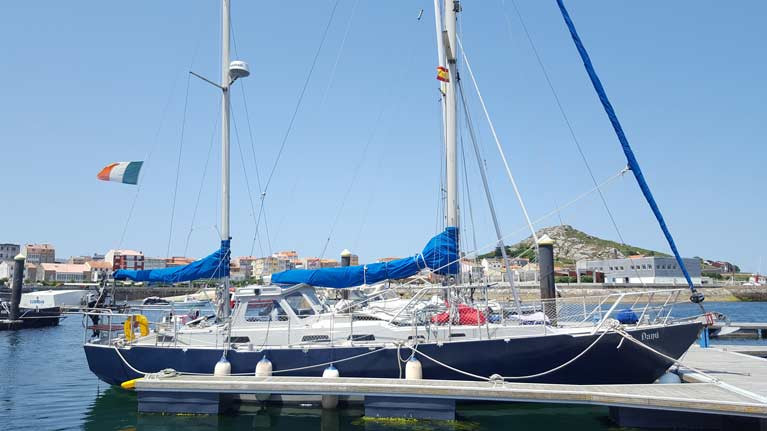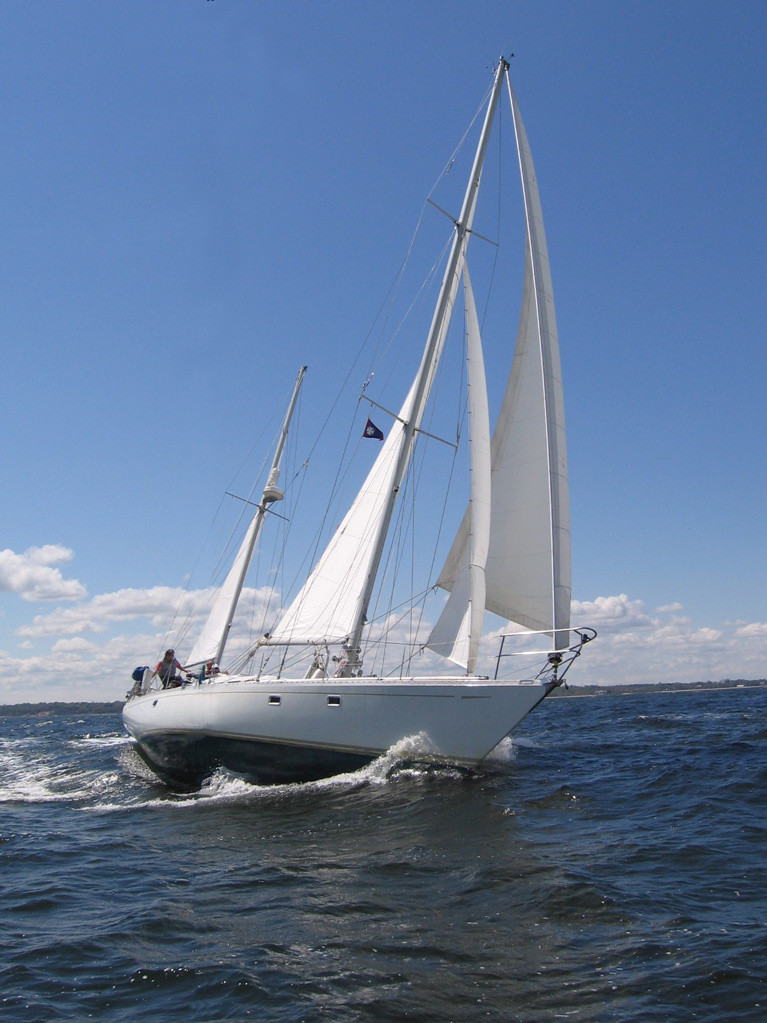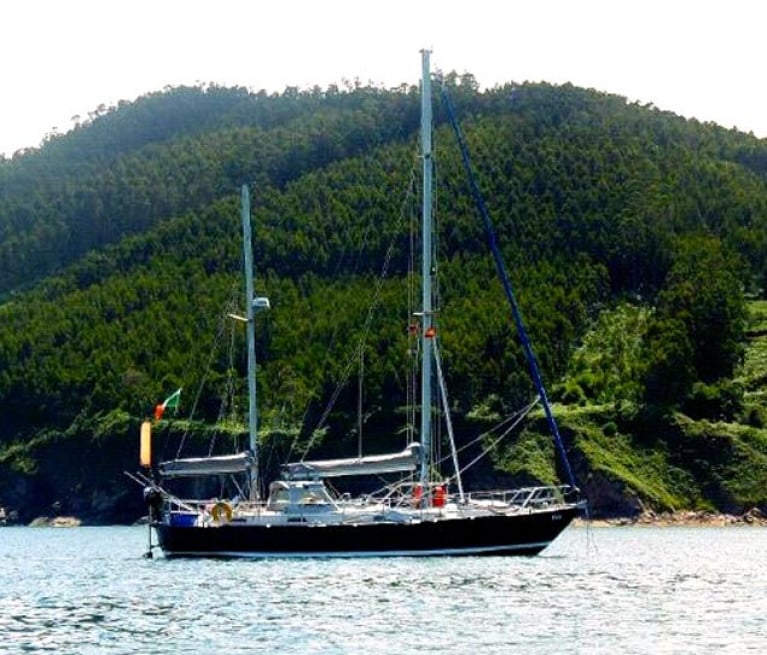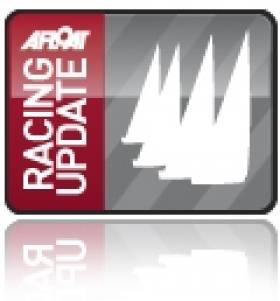Displaying items by tag: Danu
Danu of Galway, Kari & Selkie - Irish Liveaboard Families
“A steel boat will take you anywhere if it is well maintained, but knowing it inside out made all the difference,”
“You can jump onto a boat and sail it, but you can have lots of problems if you aren’t familiar with it.”
In an interview with The Sunday Times, Galway scientists and sailors Peter Owens and Vera Quinlan speak of their 14 months sailing Danú of Galway with their two children Lilian (12) and Ruairí (10) and give tips for families considering the same.
Had they dodged lightning storms, swum through a shiver of sharks and clung to a coconut sack to escape the prison on the Îles du Salut that featured in the film Papillon, the Quinlan-Owens family could not radiate more exhilaration after their 12,000 nautical mile trip, which involved quarantining in the latter stages due to Covid-19.
Lilian was a toddler and Quinlan was still on maternity leave with Ruairí when they bought Danú, a 1 Mauritius-class steel ketch in 1993 to a Bruce Roberts design.
The cost for the couple was “the price of an average family car”. However, it required a complete refit, along with a new engine and electronics, after they sailed it up from the Guadiana river on the Spanish-Portuguese border.
 Here comes the sun…..Danu’s crew as they took their departure from Ireland at the end of June 2019, with Lilian and Ruari (foreground), and their parents Peter Owens and Vera Quinlan. Photo Vera Quinlan
Here comes the sun…..Danu’s crew as they took their departure from Ireland at the end of June 2019, with Lilian and Ruari (foreground), and their parents Peter Owens and Vera Quinlan. Photo Vera Quinlan
For almost two years, Owens laboured with power tools, dust and grime in Galway docks. Through dark winter nights, he dreamed of ventures north to climb in Norway’s Lofoten islands — a trip he made when the work was done.
“We just wanted to be 100% sure of the vessel,” says Quinlan. “Experience is something you cannot buy, and with that comes the knowledge that if you have something like a catastrophic fire out in the north Atlantic, you are out of range of a helicopter rescue.” Lilian and Ruairí learnt man-overboard drills and what to do if they had to abandon ship.
“You can’t take anything with you — not even your books,” says Ruairí.
Yearning to spend more time with their young family
A yearning to spend more time with their young family was also shared by Phillida Eves and Tedd Hamilton, who set off from Rosscahill, in Co Galway, for the Mediterranean in July 2003.
Their children, Oisín, Cian and Soracha, were aged between nine and two, and their springer spaniel, Poppy, travelled with them on 14-metre, 30-year old Nicholson ketch, Kari, which they had bought in southern Spain.
The couple remortgaged their house, and Hamilton’s profession as a marine engineer meant he could work on “superyachts” while Eves, a teacher, could be drawn on real-life situations to give the children maths lessons, such as calculating distance for fuel.
Practical education was also the focus for Trish McDonagh, when she and her husband and two children, then aged four and seven, embarked on an extended Atlantic circuit from Cork harbour on their yacht, Selkie, between 2012 and 2015.
“I took the home-schooling seriously, but then stripped it away to maths and English, while every other subject — history, geography, science, and so on — was based on where we were,” she says. “I think the big advantage for the children was having time with both of their parents, which can be difficult enough in this world we find ourselves in.
Read more in The Sunday Times here
The Sailor of the Month contest has been running for nearly a quarter of a century now, but this may well be the first time the award has gone to a single seagoing family. Vera Quinlan, her husband Peter Owens, and their children Lillian (now 12) and Ruairi (10) departed their home near Kinvara in the southeast corner of Galway Bay with their 43ft steel ketch Danu in June 2019 in anticipation of a comprehensive Atlantic circuit cruise to South America and the Caribbean, concluding back in Galway Bay at the end of August 2020.
Despite their plans being battered by the massive international effects of the COVID-19 pandemic, Danu and her crew have managed to finish a very complete voyage of remarkable variety, and they thoroughly deserved the warm welcome and congratulations they received from family and friends when they arrived back into Kilronan in the Aran Islands on Wednesday 29th July.
Last night (Wednesday) the 43ft steel ketch Danu made her way round the end of the breakwater at Kilronan in the Aran Islands in the evening light, with the day’s rain clearing away to the northeast. The Quinlan-Owens family of Kinvara had returned safely to home waters after a Transatlantic circuit cruise in which they had achieved much, despite some of their plans being curtailed by the COVID-19 pandemic.
In keeping with current circumstances, they returned to a warm but subdued numbers-limited welcome. It was a very special occasion nevertheless, as in port in Kilronan to greet them were Vera Quinlan’s father Fergus with his wife Kay on their world-girdling 12 metre cutter Pylades, whose home base is at Bell Harbour in North Clare close west of Kinvara, while from their own anchorage in the approaches to Kinvara were Conor and Breda Minogue with their young sons Micheal (11) and Tomas (8) on their classic Bowman 40 Golden Harvest, another veteran of transoceanic passages.
With their daughter Lilian (now 12) and son Ruairi (10), the Quinlan-Owens family make for a formidable voyaging and shoreside exploration team, as Vera is a scientist with the Marine Institute, while Peter’s speciality is the exploration of rugged and out-of-the-way places ashore. Thus before they’d even left the eastern side of the Atlantic for the hop across to South America from the Cape Verde islands, they’d had detailed expeditions into the Picos de Europa in northern Spain, and the Atlas mountains in Morocco.
After Christmas spent in a jungle river in Guyana, they started making their way up the chain of the Caribbean Islands in the New Year, but then had to plan carefully in order to avoid being trapped by the rising COVID-19 pandemic. The French islands were being particularly strict in imposing total lockdown which stopped all movement, but by getting themselves to Antigua where - with tests done and clearance provided to sail for some parts of Europe – they departed on the first stage of the long haul home. Their best hopes lay in reaching the forward-looking administration in the Azores, where the authorities were making every effort to accommodate long-distance cruisers, while still adhering to their own guidelines.
As reported in Afloat ie, Danu’s crew timed their Azores arrival to near-perfection, with a minimum time in quarantine, while – as Vera admits – a bit of the “Galway gab” ensured that they were the first visiting cruising yacht to be given pratique to sail at will among the pandemic-free islands. Thus although their hopes of some cruising on the US eastern seaboard had to be abandoned, they had a wonderful time cruising the Azores in some detail before gathering themselves for the 1,100 mile passage home to Galway Bay in a period when the North Atlantic is in a decidedly restless mood.
Despite that, last night saw Danu safely in Kilronan, very much within reach of home and gradually adjusting to a different style of life, with everyone wondering just when Ruairi will decide to get a haircut.
 The Quinlan-Owens family’s Bruce Roberts 43 steel ketch Danu, built in 1993, was much up-graded by Peter and Vera before the voyage
The Quinlan-Owens family’s Bruce Roberts 43 steel ketch Danu, built in 1993, was much up-graded by Peter and Vera before the voyage
Today (Monday), the Quinlan-Owens family from Kinvara on Galway Bay with the Atlantic-circuiting 39ft steel ketch Danu have been finally free to roam ashore as they please in Horta on Faial in the Azores, as the next phase in the lifting of the COVID-19 restrictions in the islands is reached.
Portugal and its islands of the Azores have had a marginally better record than Ireland in dealing with the pandemic, and the outcome of this significant move, in a group of islands which have become the Atlantic crossroads and stopover port for ocean voyagers in vessels of all sizes, will be monitored with international interest.
 Welcome to Horta! The Azorean Pandemic Patrol managed to put a bit of fun into Danu’s arrival for (left to right) Vera, Lillian, Ruari and Peter, but the Kinvara crew still had to spend a night in anchored isolation
Welcome to Horta! The Azorean Pandemic Patrol managed to put a bit of fun into Danu’s arrival for (left to right) Vera, Lillian, Ruari and Peter, but the Kinvara crew still had to spend a night in anchored isolation
Danu - with Vera Quinlan, her husband Peter Owens and their children Lillian (12) and Ruari (10), arrived into Horta on Wednesday after a 25-day passage from Antigua, their progress having been slowed by light airs and headwinds. While their welcome to the Azores was as warm as it could be (Azorean Pandemic Patrols manage to put a bit of fun into a tedious process), they were still obliged to anchor in isolation in the Outer Harbour under quarantine, but as Vera reveals, with a bit of the “Galway gab”, after a day or so they secured a pontoon berth inside the quarantine quay.
 Finally there……a bit of the “Galway gab” secured Danu a pontoon berth – albeit still quarantined – after a day outside. Photo: Vera Quinlan
Finally there……a bit of the “Galway gab” secured Danu a pontoon berth – albeit still quarantined – after a day outside. Photo: Vera Quinlan
This allowed them freedom to walk or run or cartwheel or even try the conga (if you stayed in the family bubble) every last metre of the 300 metres of the Quarantine Quay. Most of us wouldn’t even look at it for a nano-second as an option for our daily constitutional, but after being hot and bothered and becalmed and all in the same boat out in the Atlantic, it seemed like boundless paradise………
 Access to the Quarantine Quay provided Danu’s crew with just 300 metres of shore-walking space for their first three days in the Azores, but it made quite a difference to the wait for the restriction-lifting. The time-honoured custom of painting your boat’s name and home port (and sometimes lots of other details too) onto the harbour wall at Horta has reached such a level that every bit of space – vertical, horizontal and overhead - is now being covered. Photo: Vera Quinlan
Access to the Quarantine Quay provided Danu’s crew with just 300 metres of shore-walking space for their first three days in the Azores, but it made quite a difference to the wait for the restriction-lifting. The time-honoured custom of painting your boat’s name and home port (and sometimes lots of other details too) onto the harbour wall at Horta has reached such a level that every bit of space – vertical, horizontal and overhead - is now being covered. Photo: Vera Quinlan
But now, the world of Horta and Faial and the Azores is theirs to explore, and of course they’ll have to make their number in due course at Peter’s Café Sport, the heart of Horta for the ocean voyager.
Galway’s Transatlantic Ketch Danu Arrives Safely in Azores
The Quinlan-Owens family of Kinvara on Galway Bay arrived safely in Horta in the Azores this morning after a slow calm-plagued passage from Antigua in the Caribbean. It was all well on board for Marine Institute scientist Vera Quinlan, her husband Peter Owens, and their children Lillian (12) and Ruari (10), but the final stages had required real patience as Danu glided along with the islands well in sight at a sailing speed of only 3.5 knots.
Their Atlantic circuit cruise had been somewhat curtailed by the onset of COVID-19 and severe movement and landing restrictions in the Caribbean islands. But nevertheless, they had managed many rewarding South American and island visits on the west side of the Atlantic, and in a very complete programme, their shoreside explorations in Spain, Portugal, Morocco, the Canaries and the Cape Verde Islands on the outward passage had provided them with cherished in-depth insights into the way of life in places seldom visited in detail by the average ocean cruising crew.
Now that they are safely in Europe’s supremely beautiful Atlantic outposts of the Azores, it’s time for some relaxation, and if they stay on until next Monday (June 15th) in the quarantined anchorage in Horta’s Outer Harbour, the COVID-19 restrictions will be lifted and they can freely visit ashore throughout the Azores.
 Danu in a Caribbean anchorage. She is a 39ft 1993-built Bruce Roberts-designed ketch which Vera Quinlan and Peter Owens personally up-graded to full ocean-going standards
Danu in a Caribbean anchorage. She is a 39ft 1993-built Bruce Roberts-designed ketch which Vera Quinlan and Peter Owens personally up-graded to full ocean-going standards
Today is World Oceans Day Monday, June 8th, and the 39ft ketch Danu of Galway Bay has an Azores landfall in prospect for celebration as she approaches the ocean-crossroads port of Horta in the island of Faial.
Although still 150 miles from Horta itself, Danu and her Quinlan-Owens family crew are within the ambit of the Azores archipelago after a month of voyaging northeastwards across the Atlantic from Antigua in the Caribbean. There, the Danu plans for detailed exploration in the islands as the highlight of an Atlantic circuit cruise had been greatly curtailed by the onset of COVID-19, with particularly severe restrictions being imposed on visiting boats and their crews by the small and vulnerable island communities.
 Plenty of fair wind on the outward leg as Vera Quinlan oversees the placing of an Argo Research Float for Ireland’s Marine Institute – it was launched at mid-ocean last December on the westward voyage and has been transmitting useful information back to the Institute in Galway ever since
Plenty of fair wind on the outward leg as Vera Quinlan oversees the placing of an Argo Research Float for Ireland’s Marine Institute – it was launched at mid-ocean last December on the westward voyage and has been transmitting useful information back to the Institute in Galway ever since
Nevertheless, Danu’s crew have much to celebrate on this special Oceans Day, as Vera Quinlan is a scientist with the Marine Institute in Galway. While she has taken a sabbatical with husband Peter Owens, daughter Lillian (12) and son Ruairi (10) to make this voyage, Danu carried a scientific Argo research float from the Marine Institute which was duly launched at mid-ocean last December on the westward voyage and has been transmitting useful information back to the Institute in Galway ever since.
 Proper crew members now – Ruari (10) and Lillian (12) have both been standing Watches independently on the eastward passage
Proper crew members now – Ruari (10) and Lillian (12) have both been standing Watches independently on the eastward passage
The return voyage has been less favoured with fair winds but much-plagued by calms, yet Lillian and Ruari have been adding to their experience with being entrusted to stand their own watches. Increasingly, the prospect of very slow sailing progress in light winds became a matter of increasing concern, but the camaraderie of the sea manifested itself in the friendliest possible way when a passing ship transferred 200 litres of fuel to Danu, and since then they have been plodding on for much of the time at their most economical motoring speed of 4.6 knots, which means they may not reach Horta until Wednesday.
That may be no great hardship, for the word is that the Azores will be lifting COVID-19 restrictions in a week’s time on Monday, June 15th. Although Danu may have to stay in quarantine anchored in the Outer Harbour until then, her crew will have access to sanitized supplies, and if they stay on until next Monday, they’ll be free to go ashore and visit other islands before heading for Galway Bay.
 Horta in Faial in the Azores, the cross-roads port for Transatlantic voyagers. Under current regulations, Danu will have to anchor in part-quarantine in the Outer Harbour until next Monday (June 15th), but then COVID-19 restrictions will be lifted throughout the Azores
Horta in Faial in the Azores, the cross-roads port for Transatlantic voyagers. Under current regulations, Danu will have to anchor in part-quarantine in the Outer Harbour until next Monday (June 15th), but then COVID-19 restrictions will be lifted throughout the Azores
Today, all being well, a flotilla of eight boats will be leaving Antigua, bound Transatlantic for Europe in the hope of being well clear of the Caribbean before the hurricane season sets in. Included in the group will be the Galway Bay 39ft ketch Danu with Marine Institute scientist Vera Quinlan, her husband Peter Owens and their two children Lillian (12) and Ruari (10).
In all, there are about 150 Ocean Cruising Club boats spread through the Caribbean, and anxious to get clear of the sometimes extreme Covid-19 lockdown in the islands. Ocean CC Vice Commodore Daria Blackwell has been much involved in advising and coordinating this movement, working from the home on the shores of Clew Bay in Mayo where she lives with husband Alex Blackwell.
 The Quinlan-Owens family’s ketch Danu hopes to depart Antigua today for the almost 4,000-mile voyage back to Ireland, possible with a brief stop at the Azores. Photo: Peter Owens
The Quinlan-Owens family’s ketch Danu hopes to depart Antigua today for the almost 4,000-mile voyage back to Ireland, possible with a brief stop at the Azores. Photo: Peter Owens
Some of the crews in the Caribbean have experienced decidedly harsh lockdown treatment at the hands of the island authorities, and while many are prepared to sail non-stop until they reach their own home waters, others are encouraged by the fact that the authorities in the Azores have indicated that they will do everything possible within their own restrictions to help the voyagers on their way.
Included among the voyaging hopefuls is Garry Crothers from Derry and Lough Swilly Yacht Club with his 43ft aluminium cruiser Kind of Blue, whose problems are particularly acute as expected crew have been unable to join him, and when he says he may have to sail single-handed, he really means it as he lost an arm in an accident some years ago.
More on this story and others in this account in the Guardian newspaper here and in this interview on the BBC World news here
The family crew of the 13 metre Bruce Roberts steel ketch Danu from Galway Bay hope to start their long Transatlantic voyage home from Antigua this weekend. The oceanic circuit cruise started nearly eleven months ago when Marine Institute scientist Vera Quinlan, her husband Peter Owens and their children Lilian (12) and Ruari (10) departed southward from Kinvara last June.
In a very competent and complete venture, they’ve savoured the total Atlantic experience on the ocean, and on both sides of it too, with detailed inland expeditions ashore – sometimes far inland – and a decidedly unusual Christmas spent up a river in South America in the heart of a dense tropical forest.
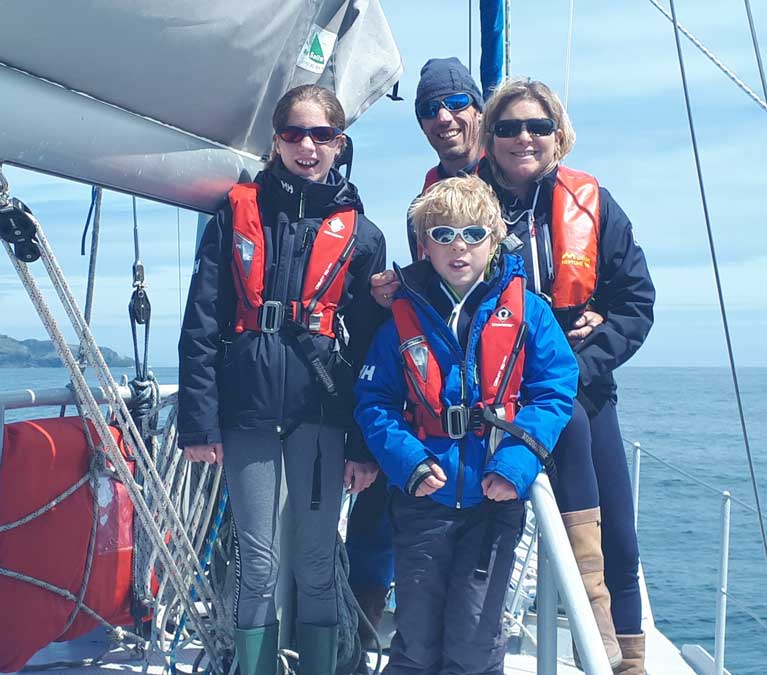 Here comes the sun…..Danu’s crew as they took their departure from Ireland at the end of June 2019, with Lilian and Ruari (foreground), and their parents Peter Owens and Vera Quinlan. Photo Vera Quinlan
Here comes the sun…..Danu’s crew as they took their departure from Ireland at the end of June 2019, with Lilian and Ruari (foreground), and their parents Peter Owens and Vera Quinlan. Photo Vera Quinlan
The reward for all this sometimes very muddy exploration was the glorious sailing northward up the islands of the Caribbean across sparkling seas, and though the increasing spread of the Covid-19 restrictions has made passage planning more complex, they have managed to modify their cruise to accommodate the new situation.
Thus when a four week lockdown was imposed, they’d got themselves to Barbuda which, as Vera reports, “is not a bad place to be stuck…..”. Since then they’ve made the 30 mile passage to Antigua where they’ve been in isolation while re-stocking the ship for the Transatlantic voyage back towards Ireland. It’s a passage which is just under 4,000 miles in all, though they hope to have a short break in the Azores if the pandemic situation has sufficiently resolved itself by that time.
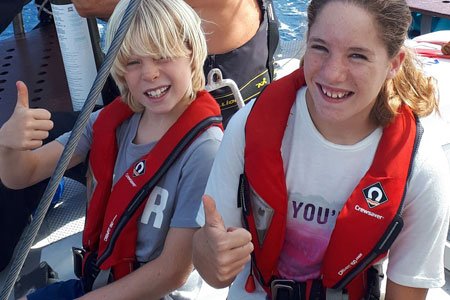 Children of the sea – Danu’s junior crew of Ruari and Lilian are with their parents in facing into a 4,000-mile voyage. Photo: Vera Quinlan
Children of the sea – Danu’s junior crew of Ruari and Lilian are with their parents in facing into a 4,000-mile voyage. Photo: Vera Quinlan
Irish Skipper Glen Ward Leads Three Peaks Yacht Race
An Irish debutant in the Three Peaks Yacht Race is leading the fleet after four days of competition off the coast of Scotland.
The Barmouth to Fort William Three Peaks Yacht Race combines yachting and mountain running and cycling into one of the greatest adventure challenges in British sport.
Danu Technologies skippered by Glen Ward is staying ahead of White Clouds and then Team Whistler this afternoon after passing the the Sound of Jura, notorious for becalming boats and forcing them to row, and there are several tidal gates ahead for them to negotiate as they make their way through the Inner Hebrides up to Fort William.
Five team members are allowed, comprising a combination of sailors and runners, their aim is to sail from Barmouth, on the Welsh coast, to Fort William in Scotland, via Caernarfon and Whitehaven, climbing the highest peaks in Wales, England and Scotland on the way.
The race is open to mono-hull yachts only and engine power can only be used close to port, but yachts can be rowed, even pulled along by crew members on the shore but cannot have outside assistance. Its a straight race and the first team to get their runners back to the finish line in Fort William, having completed all the mountains, wins the coveted Daily Telegraph Cup.
It is hard to predict but a finish tonight is likely, and with the runners from the leading two evenly matched, there could yet be a repeat of last year when the runners decided the race on the final Ben Nevis run.
Team Danú Technologies from Dublin, is completely new to this event and although they say their main goal is to finish the race, they also say hey will definitely take every opportunity to snatch victory along the way too!
Danú Technologies is skippered by Glen Ward who has more recently been sailing the boat in single-handed offshore races.
Deon McNeilly, Newcastle AC and Gary Bailey, Mourne Runners are the legs of the team. Deon is looking for new challenge having won most mountain running events in Ireland over the years, including the 2010 Mourne 2 day Elite, while Gary has an excellent record in ultra events winning the 2010 26Extreme Ireland Coast to Coast involving 200miles of running, cycling and kayaking
Essentially, it is 'taking part that counts' and exactly what the less active sailing crew will be suggesting to our runners. Andrew Miles from Manchester is the youngest member of the crew whom has been chasing a chance to participate in this race for the last 5 years! A recent graduate who campaigns an 18ft Skiff. John Prudhoe is the fifth Team member and will be responsible for navigation and weather routing.
Danú Technologies is a Ker35 Built in 2001 and was originally designed for the grand prix IRM rule.


























